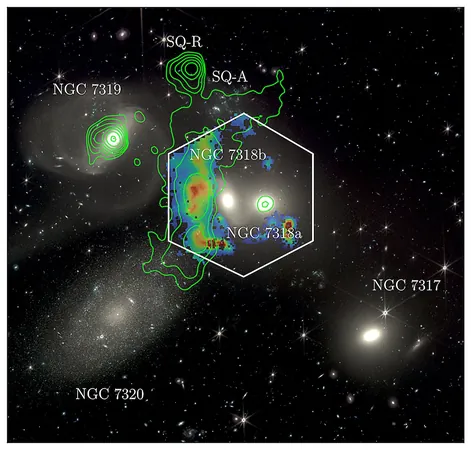
Unthinkable Galaxy Collision Revealed at 2 Million MPH – A Cosmic Spectacle Like No Other!
2024-11-22
Author: Wei
Groundbreaking Astronomical Observation
In a groundbreaking astronomical observation, scientists have captured the awe-inspiring spectacle of a galaxy crash occurring at a mind-boggling speed of 2 million mph (3.2 million km/h). This remarkable event was witnessed within Stephan's Quintet, a cluster of five galaxies located just a stone's throw away from our own Milky Way.
A Powerful Shockwave
The collision provided a shockwave of immense power, comparable to the 'sonic boom' produced by a jet fighter, shedding light on the chaotic and dynamic nature of galactic interactions. For nearly 150 years, Stephan's Quintet has served as a cosmic laboratory, revealing the remnants of past galaxy collisions that have sculpted this extraordinary region in space.
Discovery of NGC 7318b
This latest discovery centers on the galaxy NGC 7318b, which has pierced through the interstellar space of the Quintet, reigniting a previously dormant field of debris and gas. Utilized for the first time in this observation was the advanced WEAVE spectrograph at the William Herschel Telescope in La Palma, Spain, a project funded by €20 million (approximately $16.7 million) to explore the vastness of our universe.
Insights from Dr. Marina Arnaudova
Dr. Marina Arnaudova from the University of Hertfordshire, the lead researcher, eloquently described the scene: 'The dynamical activity in this galaxy group has now been reawakened... leading to an immensely powerful shock, much like a sonic boom from a jet fighter.'
Dual Nature of Shockwaves
Furthermore, the research team, composed of over 60 astronomers, has made an extraordinary revelation regarding the dual nature of the shockwaves generated by NGC 7318b’s passage. As this shock traverses through cooler pockets of gas, it moves at hypersonic velocities, significantly affecting the surrounding gas cloud. 'It is strong enough to rip apart electrons from atoms, leaving behind a glowing trail of charged gas,' Dr. Arnaudova noted.
Compression of Hot Gas
Contrastingly, when the shock enters regions of hot gas, it becomes less intense, acting instead to compress the surrounding matter. Ph.D. student Soumyadeep Das further explained, 'Instead of disrupting the hot gas, the weaker shock creates radio waves, which can be detected by facilities like the Low Frequency Array (LOFAR).'
Advanced Observation Techniques
The unprecedented level of detail in this observation has been attained by combining data from WEAVE's Large Integral Field Unit (LIFU) with other stellar instruments, including the renowned James Webb Space Telescope and the Very Large Array.
International Collaboration
Developed through an international collaboration involving France, Italy, and various partners from the Isaac Newton Group of Telescopes, WEAVE is designed to enhance our understanding of galactic composition while providing revelations about star formation across the cosmos.
Looking to the Future
This project is more than just about the present findings; it's a stepping stone into uncharted territories of astronomy. Dr. Daniel Smith from the University of Hertfordshire commented on the promising future, stating, 'This first WEAVE science paper is merely a taste of the abundance of discoveries that lie ahead as WEAVE fully operationalizes over the next five years.'
Community Excitement
Excitement within the scientific community continues to grow, with Professor Gavin Dalton, WEAVE’s principal investigator, highlighting that the observations not only deepen our comprehension of Stephan's Quintet but could also shed light on the faint galaxies observed at the edges of current astronomical capabilities.
Conclusion
In the words of Dr. Marc Balcells, director of the Isaac Newton Group of Telescopes, 'The data gathered from WEAVE's initial light already signals a high-impact result... this is just a glimpse of the groundbreaking discoveries awaiting us in the cosmos.' As we stand on the brink of new astronomical revelations made possible by advanced technology like the WEAVE spectrograph, the universe has never seemed more captivating and full of mysteries yet to unfold! Stay tuned, as we continue to delve into the cosmos and explore the spectacular phenomena that lie beyond our reach!




 Brasil (PT)
Brasil (PT)
 Canada (EN)
Canada (EN)
 Chile (ES)
Chile (ES)
 España (ES)
España (ES)
 France (FR)
France (FR)
 Hong Kong (EN)
Hong Kong (EN)
 Italia (IT)
Italia (IT)
 日本 (JA)
日本 (JA)
 Magyarország (HU)
Magyarország (HU)
 Norge (NO)
Norge (NO)
 Polska (PL)
Polska (PL)
 Schweiz (DE)
Schweiz (DE)
 Singapore (EN)
Singapore (EN)
 Sverige (SV)
Sverige (SV)
 Suomi (FI)
Suomi (FI)
 Türkiye (TR)
Türkiye (TR)